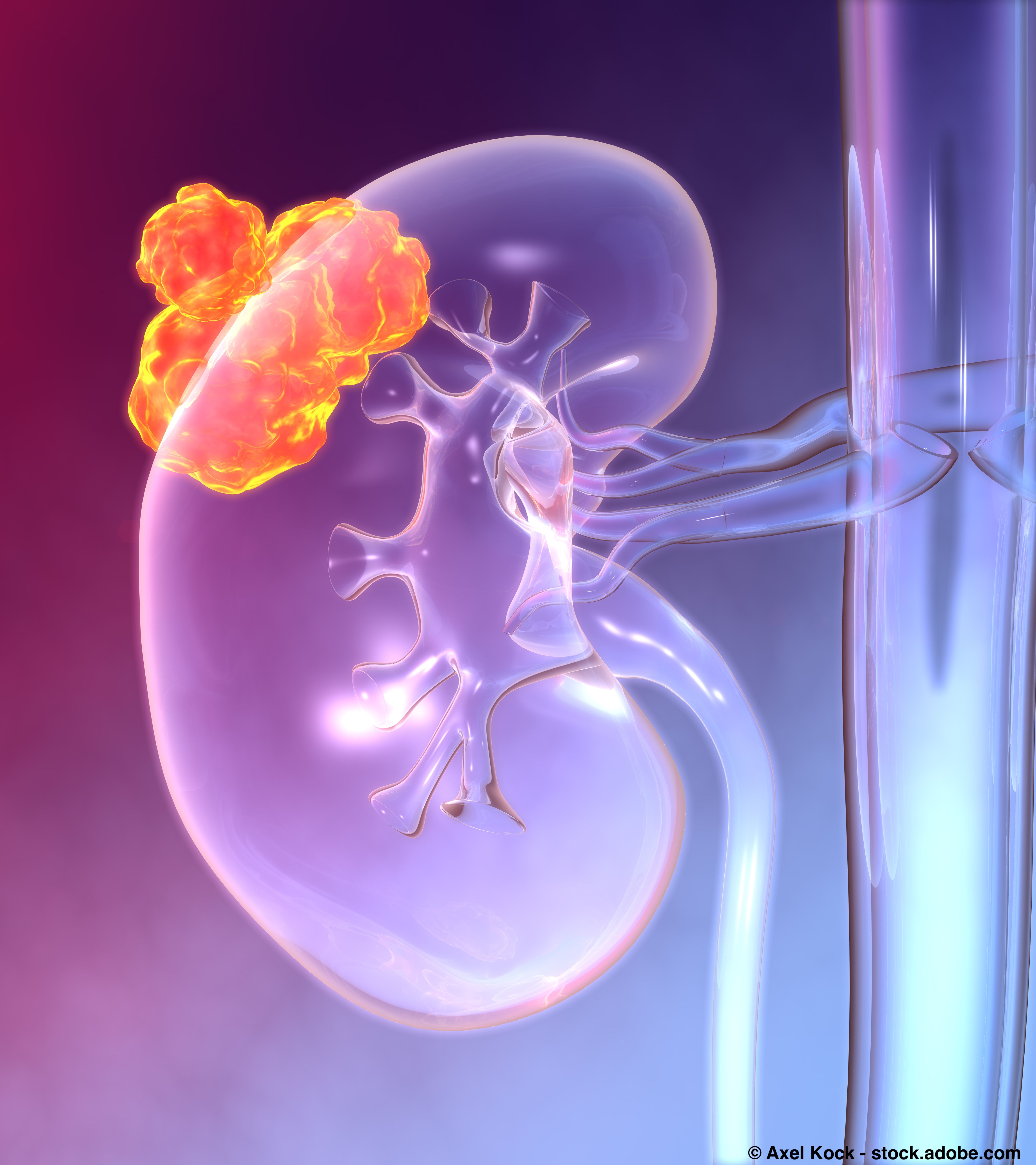Glossary
Progression-free survival: The time a patient lives without their disease spreading or worsening.
Best overall response: The best response a patient has to treatment.
Overall survival: The time a patient lives, regardless of disease status.
News
Article
Researchers showed that 1.34 mg of Fotivda provided decreased tumor size and may be more tolerable than an 0.89-mg dose among patients with renal cell carcinoma.
1.34 mg of Fotivda provided decreased tumor size and may be more tolerable than an 0.89-mg dose in RCC: © Axel Kock - stock.adobe.com

Among patients with renal cell carcinoma (RCC), the Food and Drug Administration (FDA)-approved starting dose of 1.34 milligrams (mg) of Fotivda (tivozanib) resulted in greater antitumor activity than a reduced dose of 0.89 mg, while incidence of hypertension were seen to be comparable.
Progression-free survival: The time a patient lives without their disease spreading or worsening.
Best overall response: The best response a patient has to treatment.
Overall survival: The time a patient lives, regardless of disease status.
This was according to results from an integrated efficacy and safety exposure response analysis that included the phase 3 TIVO-1, TiNivo-2 and TIVO-3 studies presented at the 2025 ASCO Genitourinary Cancers Symposium.
“[There was a] strong exposure response relationship between cycle 2 [Fotivda] serum [exposures] and progression-free survival [PFS],” Dr. Bradley McGregor, lead study author, wrote in a poster presentation of the data. McGregor is director of Clinical Research for the Lank Center of Genitourinary Oncology, a senior physician as well as Marra Lochiatto Investigator at Dana-Farber Cancer Institute, and an assistant professor of medicine at Harvard Medical School, all in Boston.
When PFS was stratified by Fotivda cycle 2 exposures quartile, data showed that those who received a higher concentration of Fotivda had the longest median PFS of patients examined. Patients with an exposure ranging from 62 to 177 ng/mL had the longest median PFS at 9.7 months and the median PFS was as follows for those with an exposure ranging from 47.9 to 62.0 ng/mL (median PFS, 9.1 months), 38.4 to 47.9 ng/mL (median PFS, 7.3 months) and 13.9 to 38.4 ng/mL (median PFS, 5.6 months).
“A correlation between [Fotivda exposures] and change in tumor size from baseline was also observed,” McGregor wrote. “Patients in the TiNivo-2 combination therapy arm who received 0.89 mg [of Fotivda] are mostly clustered in the lowest [Fotivda exposure] quartile. As [exposure] quartiles of [Fotivda] increase, patients’ tumor size decreases, indicating [a] higher [Fotivda dose] results in an increased tumor response.”
The Fotivda exposure quartile correlations with changes in tumor size and best overall response (BOR) in the tumor size model revealed the following changes in median BOR for those with an exposure ranging from: 62 to 177 ng/mL (median BOR, –23.8), 47.9 to 62 ng/mL (median BOR, –17.3), 38.4 to 47.9 ng/mL (median BOR, –11.7) and 13.9 to 38.4 ng/mL (median BOR, –7.02). The respective groups included 183, 185, 173 and 176 patients.
In TiNivo-2, the lower dose of Fotivda was given in combination with Opdivo (nivolumab), and modeling data also showed that Opdivo did not affect the pharmacokinetics of Fotivda. Additionally, the incidence of any grade or grade 3 (severe) hypertension was not significantly different between patients who received the two doses of Fotivda.
Previously, Fotivda monotherapy was approved by the FDA in March 2021 for the treatment of adults with relapsed or refractory advanced RCC following two or more prior systemic therapies based on data from TIVO-3. Data from the trial showed that the VEGFR TKI elicited a median overall survival (OS) of 16.4 months in patients (175 patients) versus 19.2 months in patients who received Nexavar (sorafenib, 175 patients). The median PFS was 5.6 months versus 3.9 months, respectively. The recommended dose of Fotivda per the prescribing information and FDA approval is 1.34 mg administered once daily with or without food for 21 consecutive days every 28 days until disease progression or unacceptable toxicity.
Fotivda was given at a lower dose of 0.89 mg for 21 days in a 28-day cycle in TiNivo-2 when it was combined with Opdivo, assuming a risk of hypertension. However, the lower-dose regimen did not improve outcomes when compared with Fotivda monotherapy given at the approved 1.34-mg monotherapy dose. A worsened trend for PFS was observed as patients treated with the doublet (171 patients) experienced a median PFS of 5.7 months versus 7.4 months with the monotherapy (172 patients).
“The results from the TiNivo-2 data set further confirmed that rechallenge with immunotherapy does not add benefit and optimal dosing of [Fotivda] provided the highest clinical benefit following progression on immunotherapy … [exposure response] models show that 1.34 mg [of Fotivda] provides greater antitumor activity than 0.89 mg. The hypertension incidence seems to be comparable, [and] these [exposure response] data suggest that a dose of 1.34 mg [of Fotivda] provides a greater decrease in tumor size and maybe more tolerable,” McGregor wrote in conclusion.
“Integrated efficacy and safety exposure response (ER) analysis of tivozanib (TIVO) for the treatment of renal cell cancer (RCC).” By Dr. Bradley McGregor, et al. Journal of Clinical Oncology.
For more news on cancer updates, research and education, don’t forget to subscribe to CURE®’s newsletters here.